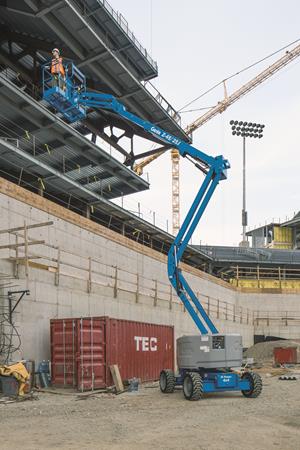
REDMOND, Wash. — In honor of OSHA’s National Fall Prevention Stand-Down, June 2—6, Terex AWP is providing the following safety tips for operating aerial lift equipment.
“Fatalities caused by falls from elevation continue to be a leading cause of death for construction workers, accounting for 269 of the 775 construction fatalities recorded in 2012. Those deaths could have been preventable,” said Scott Owyen, global training manager, Terex Aerial Work Platforms.
The following operating tips are critical steps that a mobile elevating work platform operator can take to reduce the likelihood of a potentially deadly fall from height.
- Make sure that you have received proper training (both general training and hands-on practical training), as well as familiarization on the MEWP you will be using. Thoroughly read the operator’s manual and safety signs on the machine, and understand the function and location of all safety devices and controls before beginning operation.
- Always read, understand and obey employer’s safety rules and worksite regulations, as well as all applicable local, governmental or provincial regulations that apply to MEWP operation before operating the machine.
- Always perform a pre-operation inspection and function tests on the MEWP before each shift. A level sensor, alarm or any other safety device cannot do its job if it has been disabled or has malfunctioned. If the machine fails any of these tests, make sure it is immediately tagged and removed from service until it can be repaired by a qualified service technician.
- Always perform a workplace risk assessment prior to moving the MEWP to the jobsite. Look for drop-offs and holes, slopes, slippery or unstable surfaces, overhead obstacles, power lines and any other hazards that may exist. Then consciously think about and avoid those hazards through all phases of machine operation. A full list of hazards you need to be aware of can be found in the operator’s manual for the machine you are operating.
- Always wear the proper fall protection when operating either a telescopic or articulating boom. A properly fitted full body harness and appropriate lanyard or self-retracting lifeline is an absolute requirement. Most operators do not understand the potential for being catapulted from the platform of a boom. The slightest jar at the base of the machine can equate into a sudden and powerful whiplash at the platform that may have the potential to toss the operator into the air. If this were to happen, wearing the proper fall protection may reduce the chances of serious injury or even death.
- Never sit, stand or climb on the platform guardrails for any reason. The guardrails on a MEWP provide fall protection only if the operator maintains a firm footing on the platform floor at all times. If an operator is required to reach an overhead work area that is too small for the platform guardrails to allow access to, the use of a manufacturer-approved device that has been specifically designed to provide additional access to confined spaces is recommended.
- Never exit an elevated boom or scissor lift platform unless you have been properly trained to do so, maintain 100 percent tie-off at all times, and are in possession of an approval letter from the manufacturer that provides the proper guidance.
- Never climb down from the platform when it is raised. Whenever possible, keep a cell phone or two-way radio with you while you are in the platform. Always have a rescue plan in place in the event that the MEWP is not equipped with an auxiliary lowering system or if that system malfunctions. Rescue plans should at a minimum include steps to ensure that other personnel are aware that you are operating the MEWP and that they have been trained and familiarized to operate the machine from the ground controls.
- Always keep the platform floor clear of debris. Scrap materials, buckets, large tool boxes and other items can cause a serious tripping hazard. You should remove any item from the platform that is not absolutely necessary to do your work. Utilize special manufacturer-approved attachments such as fluorescent tube caddies or panel cradles (where applicable) to lift large or bulky items.
- Always lower the platform entry mid-rail or close the entry gate before operating the MEWP. The entry mid-rail or gate is an integral part of the platform guardrail. Never tape or prop the entry open and never use a MEWP if the gate does not properly latch.


 Join our thriving community of 70,000+ superintendents and trade professionals on LinkedIn!
Join our thriving community of 70,000+ superintendents and trade professionals on LinkedIn! Search our job board for your next opportunity, or post an opening within your company.
Search our job board for your next opportunity, or post an opening within your company. Subscribe to our monthly
Construction Superintendent eNewsletter and stay current.
Subscribe to our monthly
Construction Superintendent eNewsletter and stay current.